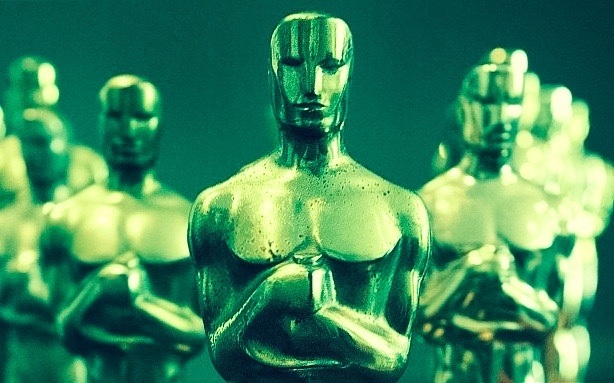
And the Environmental Oscar goes to…
Introducing the augural IoES Environmental Oscars—where researchers and other experts rate this year’s Academy Awards best movie nominees on their environmental content.
Red carpets are ready to roll, the gold statues have been polished—and speculation goes on as we await this year’s Academy Award winners.
You may have read critics’ hot takes, but how do this year’s Best Picture nominees hold up under the lenses of those who devote their lives to scrutinizing our planet’s health? UCLA’s top minds—from climate scientists to experts in environmental narratives—recently tried their hands at film review.
The relationship between Hollywood and the environment has warmed up as of late, and not a minute too soon—the planet’s warming too, with 2016 going down as the hottest year on record. Los Angeles sweltered during a summer heat wave that saw five straight days of triple-digit temperatures. Nominee La La Land’s opening dance number was filmed in 110-degree heat.
Most of us remember Leonardo DiCaprio’s Best Actor acceptance speech at last year’s Oscars, where he warned 34 million viewers about the realities of climate change. By using their platform to reach such large audiences, actors do our world a great service. Now, our environmental experts return the favor with the inaugural IoES Environmental Oscars. [NOTE: mild spoilers below.]

1. Hacksaw Ridge
– by Peter Kareiva, IoES director
True stories about true heroes. Done well, hero movies never fail to inspire us. And for those of us worried about the planet, we need some heroes at this moment in time.
Desmond Doss (Andrew Garfield), was a conscientious objector who won a medal of honor for the many lives he saved as a medic at the Battle of Okinawa in World War II. He was initially scorned by his fellow soldiers—some thought he was a coward. But for Doss, it was all about staying true to his beliefs.
It’s worth reminding ourselves that the environmental movement has its share of heroes, perhaps not as dramatic as Private Doss, but no less inspirational. Rachel Carson was impugned as hysterical, emotional and probably a communist for her now classic book Silent Spring. While weakened by cancer treatments, she went on national television for an hour-long interview to defend her views. More recently, in 2015, at least 185 environmental activists were murdered around the world for their views and actions.
We cannot all be Medal of Honor winners or Rachel Carson. But by knowing the stories of these heroes, we can all do just a little bit more, worry a little less about how others view us, make sacrifices, and maybe even speak out in public.
The current times demand more from us than convenient environmentalism.
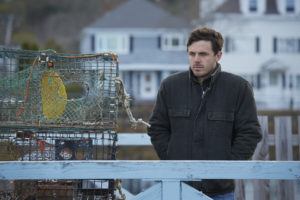
2. Manchester By The Sea
– by Alison Carruth, faculty director of LENS
Manchester by the Sea is, as many critics have acclaimed, a “searingly realistic” (LA Times) and “beautifully textured” (Variety) portrait of family tragedy and its aftermath—a narrative that orbits around Lee Chandler (Casey Affleck), his ex-wife (Michelle Williams) and his brother’s son (Lucas Hedges) in a small town on the Massachusetts Bay. “A study in individual misery” set against a “picturesque” coastal landscape (New York Times), the film is by turns wry and gut-wrenching.And yet, for all its emotional gravitas, it left this eco-critic unsatisfied.
There’s a flaw to the tragedy. And it’s not the glacial pace at which the story unfolds. As scenes of the breathtakingly blue Massachusetts coastline accumulate, we sense a missed opportunity to bring the film’s intimate stories of loss, remorse, and grit into contact with the planetary story of declining fisheries and sea level rise. The white blue-collar men at the center of this film represent a commercial fishing community that, we glean through scattered references, must rely on boat tours and jobs in Boston suburbs. But these themes remain in the background, regrettably, and what could have been a provocative environmental story remains a more predictable human drama to its final credits.
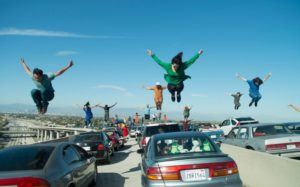
3. La La Land
– by Deepak Rajagopal, assistant professor
What will a sustainable L.A. and less cars on the streets mean for Hollywood?
As someone passionate about the unintended consequences of new innovations, watching La La Land makes me fear for the future of my beloved Los Angeles. But my concern is not about adapting to the hotter and drier reality that climate change is forecast to bring. I dread a future in which L.A. has become so sustainable that it threatens our bread and butter—the film industry.
Imagine the most consequential scenes in this wonderful movie, except in a future where driving your own car, being stuck in traffic, finding parking or getting towed—life in L.A. as we know it—has been rendered obsolete because we’re being hauled around by Uber and Lyft autonomous vehicles on sparsely filled roads. People stuck in gridlocked traffic won’t have a reason to sing and dance on freeways. Forget about a chance meeting with the love of your life in a parking lot, let alone changing plans because of bad traffic and ending up in a bar only to run into your first true love who drove a red 1982 Buick Rivera convertible.
I hope a sustainable L.A. will not lose its charms and become boring. Meantime, go see La La Land while my silly concerns still make sense.

4. Hidden Figures
– by Brad Shaffer, director of La Kretz Center
Ok, here’s a question for you. What do you think was a bigger impediment to the advancement of NASA engineers in 1961 Virginia: Gender or race?
If you’re not quite sure, check out Hidden Figures, the story of three amazing African American women whose based-on-a-true-life story is chronicled as they worked at NASA’s Langley headquarters during the height of the Soviet-U.S. space race.
Honestly, you’d have to be dead not to love this movie as it follows the trials and tribulations of Katherine Johnson, Dorothy Vaughn, and Mary Jackson confronting and challenging the prejudices that ran through the heart and soul of NASA’s pocket-protector world of engineering geeks trying to put an American in space. The film is about these women, but it’s also about the importance of science—unglamorous, difficult, data-driven science. The story is compelling, the tension builds nicely, John Glenn makes you proud, and in the end the film makes you feel good. As a scientist, and as a movie buff, I loved it. Should Hidden Figures win best picture? Go watch it and decide for yourself. Is it a great story about the importance of science in society? Absolutely.
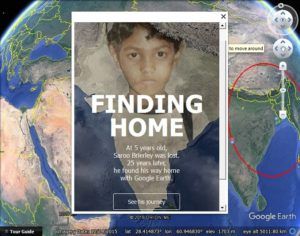
5. Lion
– by Magali Delmas, director of the Center for Corporate Environmental Performance
How much do you remember from when you were five years old? Saroo Brierley, whose real-life story is told in Lion, remembers that time vividly. He accidentally boarded a train that took him 1,600 kilometers away from his home to Calcutta. He couldn’t speak the local language, let alone find his way back, so he ended up in an orphanage and got adopted by a family in Australia. In his comfortable, grown-up Australian life, he feels the urge to find his biological family. Actually, he becomes obsessed with it, and spends every waking minute mapping his childhood odyssey through Google Earth, attempting to retrace his steps and find his native village.
This is a very emotional movie about human connections in a global information age. In the first part, the camera angle is low, showing us the world from the perspective of a vulnerable young boy lost in a place full of busy adults—who either don’t pay much attention to him, or want to take advantage of him.
In the second half of the movie, grown-up Saroo—with the support of his adoptive family, and access to education and information technologies—is able to reconnect with his biological family. The movie shows how we can remain deeply tied to one another despite many years and thousands of miles of separation. An uplifting story almost too incredible to be true that shows how information technology can help overcome frontiers.
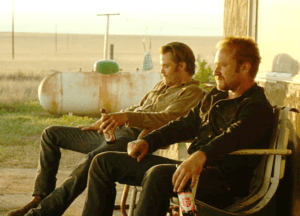
6. Hell or High Water
– by David Colgan, director of communications
On its surface, Hell or High Water is a modern Texas shoot-em-up. But drill deeper, and serious environmental and economic issues are exposed. If it feels like I’m smashing you over the head with blunt metaphors, you probably won’t like this film, because that’s exactly what it does for 102 minutes, churning away at an exploitive oil industry like the seemingly omnipresent pump jacks in the background. The film’s imagery is too obvious, from an endless caravan of pickup trucks to the aptly-named T-Bone Diner. (“All we sell is T-Bones. One time a guy came from New York City, ordered trout. We ain’t got no trout.”) Maybe that’s how it’s supposed to be. Westerns ain’t known for nuance. *spits*
Clichés aside, Hell or High Water exposes the raw wounds of rural decay. The setting is riddled with abandoned businesses, rusting junk and toxic masculinity. Antihero bank robbing brothers steal to pay debts incurred when oil companies encumbered their family’s land. The despair is palpable. One robber, Toby Howard (Chris Pine), reflects that “I’ve been poor my whole life. So were my parents and their parents before them. It’s like a disease.” The film ties this mood of inevitability and nihilism to the Native American experience. Texas Ranger Alberto Parker (Gil Birmingham), a Comanche, empathizes with the robbers while staring at a bank: “A hundred and fifty years ago, all this was my ancestors land: everything you can see. Now it’s being taken from them, except it ain’t no army doing it. It’s those sons of bitches right there.” All in all, the film delivers a dark illustration of the human condition: greedy and desperate, yet powerless against forces that dictate survival. In this context, one understands how hard it must be for some to care about seemingly distant threats like global warming.

7. Moonlight
– by Aradhna Tripati, associate professor
The film Moonlight explores the life of a young black man growing up in Miami, the relationships he forms, and the self-discovery he goes through. Many of his experiences are ones that people can relate to; from experiencing bullying to peer pressure to finding sanctuaries and developing agency. The protagonist’s experience is shaped by their environment. The environmental degradation of drugs and poverty and what that does to a person is a devastating window, and may be analogous to the physical world. Resilience, but at what cost?
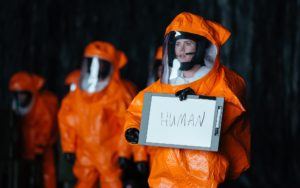
8. Arrival
– by Robert Eagle, assistant professor
The film Arrival introduces a twist into the science fiction trope of first contact with aliens. Breaking with the Hollywood convention of only bothering to contact good-looking Americans, in this case the aliens simultaneously dispatch 12 enormous, egg-like structures to nations as diverse as China, Russia, Pakistan and Sudan, as well as the U.S. Each egg contains a host of floating arthropod-like aliens seemingly interested in peaceful discourse with the local human population. As human translators work to understand the alien’s symbolic language, a potential mistranslation leads to threats of apocalyptic war not just between earthlings and aliens, but also between human nations. Fortunately, American linguist Dr. Louise Banks (Amy Adams), is plucked from lecturing to sleepy undergraduates on the Portuguese Romantics to save the day by constructing a common dialogue between aliens and humans, and helping everyone recognize a common interest—the survival of the human race.
As result of translating the alien language, Banks unlocks the gift the visitors intended to bring to earth; foresight into the future. One thing she’s able to see is the premature death (as a teenager) of her as yet unborn child. She grapples with the ethics of pursuing the same course into the future and whether to tell her husband about what she’s seen.
What lessons might environmentalism in the 21st century draw from all this? Not necessarily that we should listen more to university professors, but rather that we need to develop an inclusive dialogue to more successfully articulate that taking action on such issues is in the interests of everyone, not just a few of us. It also touches on the ethics of environmentalism as we consider the legacy we leave behind for future generations, especially as our ability to understand and predict the future consequences of human activities grows.

9. Fences
– by Peter Kareiva, IoES director
This movie adaptation of August Wilson’s stage play is filled with humanity—so much humanity that there is little room for nature. The human tragedy of; unfulfilled dreams, lost opportunities, the legacy of racism, casualties of war, father-son and husband-wife derailments in this movie, suck all the air out of the room. Who can possibly care about climate change when a father and son manage to do so much damage to one another? And why would anyone speak of biodiversity loss when a marriage loses all trust and becomes a barren prison of duty?
Scientists talk of the Anthropocene—this Age of Man—to emphasize how humankind impacts and dominates the planet. But this calculated assessment of humanity’s role seems off-target after watching Fences. This movie reminds us that whatever we do to address climate change, or to halt deforestation, will be done through the actions and commitments of people whose lives are filled with near-misses, pain and heartbreak. The act of caring about the environment is possible only if a person is not bent down with their own tragedies or suffering. The environment is in the end all about people. Conservation is all about people. If it is nature we wish to save, we must care as much about people as we do nature.
And for today’s world, Denzel Washington’s character Troy Maxson had perhaps the best advice possible, “you got to take the crookeds with the straights.” Right now in the United States, we in the environmental movement are taking the crookeds. But we will get to the straights.

